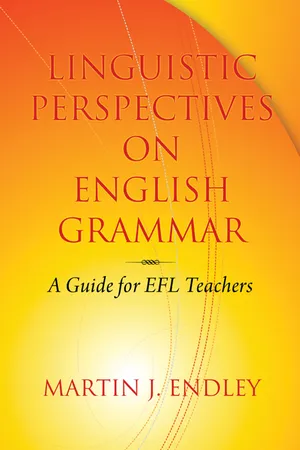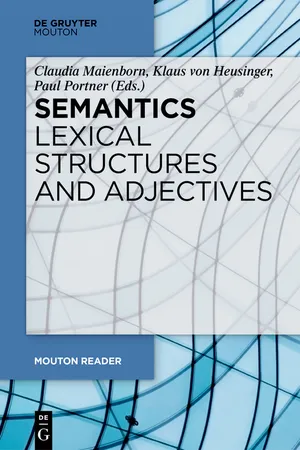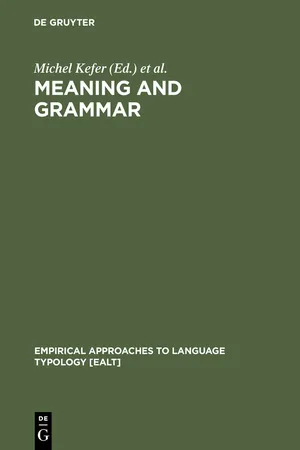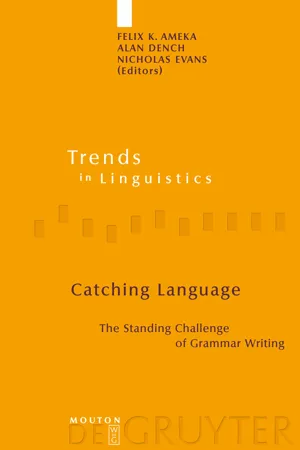Languages & Linguistics
Descriptive Adjectives
Descriptive adjectives are words that modify or describe nouns and pronouns by providing additional information about their qualities, characteristics, or attributes. They can be used to express color, size, shape, texture, taste, smell, sound, and more. In language, they play an important role in creating vivid and detailed descriptions of people, places, things, and ideas.
Written by Perlego with AI-assistance
Related key terms
1 of 5
5 Key excerpts on "Descriptive Adjectives"
- eBook - PDF
- Martin J. Endley(Author)
- 2007(Publication Date)
- Information Age Publishing(Publisher)
Thus, after one particular class, one of my colleagues might say the follow- ing to me: Adjectives and Adverbs in Linguistic Perspective 93 (29) The students were being very Korean today. In one sense, this is an odd thing to say. We do not normally think of “Korean” as a property that is subject to change. Surely one either is Korean or one is not. When used in this way, however, the adjective is being treated as if it were a dynamic property, something that is changeable. Given an appropriate context, it would not be difficult to make sense of an utterance like (29). If I heard someone say this, I would understand it to mean that the students had been displaying many of the characteristics we often as- sociate with Korean students, but to a greater degree than normal. (I will leave you to decide what those characteristics are!) Adjectives as Attributive and Restrictive One basic function that adjectives perform is to attribute some property to an entity identified by a noun. Consider a noun phrase such as the students. Of course, it is certainly possible to use this without an adjective. However, speakers will very often want to add something more. For example: (30) a. The happy students. b. The thoughtful, witty students. c. The intelligent, diligent, attentive students. The adjectives happy, thoughtful, diligent, and so on provide additional information about the students. One effect of this is to restrict the range of possible items to which the entire NP (including the adjective) can apply. To give another example, the expression All the students in the class includes everyone in the room; however, All the smiling students in the class restricts the reference to only some students (those who happen to be smiling). Adding further adjectives restricts the reference still further: All the smiling, attentive students. You get the idea. By attributing some property to the noun, adjectives help to establish the reference of the noun more precisely. - Claudia Maienborn, Klaus von Heusinger, Paul Portner(Authors)
- 2019(Publication Date)
- De Gruyter Mouton(Publisher)
This semantic definition of adjectives as one-place properties is coherent with the fact that many languages do not have a part of speech class of adjectives, and nouns and verbs are then used to cover its prototypical functions (Dixon 1977; Croft 1991). However, the argument for the necessity to represent common sense ontology in formal semantics is strong since in languages with a productive, open class of adjectives there are very clear general syntactic, morphological and semantic criteria distinguishing adjectives from verbs and nouns. 2 Main characteristics of adjectives The purpose of this section is to briefly determine which are the specific morpho-syntactic and semantic properties that characterize the class of adjectives. There are at least two ways to give support to the assertion that adjectives are a semantic and syntactic category with specific properties distinct from nouns and verbs. One way is to discuss the differences between adjectives and intransitive verbs and adjectives and nouns (see Hamann 1991: §1.2, §1.3 and Baker 2003 for this discussion). The other is to present what could be called prototypical syntactic and semantic features of the category adjective (Larson & Segal 1995; Demonte 1999). Both approaches will be combined in the following short discussion about the main characteristics of adjectives. 12 Adjectives 383 2.1 Adjectives are modifiers The definition of adjectives as functions from entities to truth values captures adequately the predicative use of adjectives ( This person is intelligent ). However, all authors agree that the primary function of adjectives is to modify nouns directly in structures like an intelligent person . As a consequence, adjectives have often been assigned to the category CN/CN. If CN is a primitive both for N and A, the complex category CN/CN defines adjectives as the category able to combine with common nouns to form new common nouns.- eBook - PDF
Meaning and Grammar
Cross-Linguistic Perspectives
- Michel Kefer, Johan van der Auwera, Michel Kefer, Johan van der Auwera(Authors)
- 2013(Publication Date)
- De Gruyter Mouton(Publisher)
1. Languages with a distinct open adjective class. 2. Languages with a rather small, closed set of adjectives. Adjectival concepts not included in the adjective class are typically expressed as verbs or nouns. 3. Languages which have no distinct class of adjectives at all, either open (as in 1.) or closed (as in 2.). Two subgroups of languages can be distinguished here: 224 Harrie Wetter a. adjectival-noun languages: adjectival concepts are primarily expressed as (subclasses of) nouns. b. adjectival-verb languages: adjectival concepts are primarily expressed as (subclasses of) verbs. Schachter's description is representative for the way the variation in the expression of adjectival meanings is generally discussed in the literature (for a similar view see, for instance, Locker 1951; Dixon 1977; Givón 1979, 1984). Basically three types of lexical categorization are distinguished: adjectival concepts are encoded cross-linguistically as Adjectives, as (adjectival) Verbs or as (adjectival) Nouns. This more or less standardly accepted description, primarily based on the part-of-speech status of adjectivals 3 , can be thought of as a typology of the ways adjectival meanings are expressed in language. - eBook - PDF
Catching Language
The Standing Challenge of Grammar Writing
- Felix K. Ameka, Alan Dench, Nicholas Evans, Felix K. Ameka, Alan Dench, Nicholas Evans(Authors)
- 2008(Publication Date)
- De Gruyter Mouton(Publisher)
6. Description as explanation In describing the contrast between description and explanation here, I am following common parlance among functionalists in restricting the term explanation to explanations for why languages are the way they are. But there is a sense in which what I am calling descriptions are themselves explanatory at a different level. Namely, if the grammar is a representation of what is inside speakers’ heads and hence what underlies linguistic behaviour, then the grammar itself can be viewed as part of the explanation for linguistic behaviour, and the grammar serves as an explanation for particular facts of the language. The reason that speakers of English do not say things like *My house is a house blue rather than things like My house is a blue house is because the grammar of English states that attributive adjectives precede the noun, and there is a sense in which the grammar of English explains this fact about language use. A similar point is made by Greenberg (1968: 180): In descriptive linguistics, even grammatical rules of the conventional sort are explanatory of particular phenomena ... . If, for example, a student who Descriptive theories and explanatory theories 225 is just learning Turkish is told that the plural of di (tooth) is di ler while that of ku (bird) is ku lar , he may ask why the first word forms its plural by adding -ler while the second does so by adding -lar . He may then be told that any word whose final vowel is -i takes -ler , while one in which the final vowel is -u takes -lar . This may be considered an explanation, insofar as further interrogation has to do with classes of words that have -i and -u as their final vowel rather than with the individual forms di and ku . - eBook - PDF
- Harrie Wetzer(Author)
- 2013(Publication Date)
- De Gruyter Mouton(Publisher)
If we consider the various descriptive grammars of individual languages, there appears to be no consistent pattern according to which adjectivals are treated as either Adjectives or adjectival Nouns or Verbs cross-linguistically. Evidently there is no consensus among grammarians about the status of distinctive proper-ties as differences of kind or differences of degree. As an example, consider the attributive function of adjectivals. In many lan-guages the specific syntactic behaviour of adjectivals used as modifiers in a noun phrase is an important criterion for the recognition of a distinct adjective class. Cross-linguistically, however, adjectives, defined as a distinct word class, are not 36 2. Adjectival encoding in language: The standard approach necessarily characterized by distinct syntactic behaviour in attributive construc-tions. Syntactically, the inflected adjectives in Japanese, for instance, are not different from verbs when used as adnominal modifiers (see examples (2.11) and (2.12) in section 2.2.1.). In other languages, adjectivals do behave differently in attributive position, but their distinctive behaviour does not result in the recogni-tion of a separate adjective class. In Mojave and Mandarin Chinese (and many other languages) adjectivals are treated as (a subclass of) verbs, and not as adjec-tives, despite their grammatical differences from (other) verbs (see examples (2.26) and (2.28-2.29) in section 2.2.2.). In short, the distinct syntactic behav-iour of attributive adjectivals appears to be neither a necessary criterion (cp. Japanese), nor a sufficient criterion (cp. Mojave and Mandarin Chinese) for adjective-hood.
Index pages curate the most relevant extracts from our library of academic textbooks. They’ve been created using an in-house natural language model (NLM), each adding context and meaning to key research topics.




